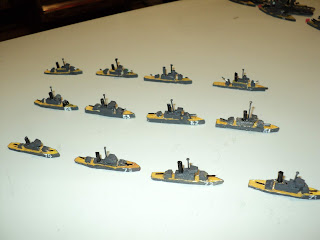One of my favourite 'go-to' blog spot writers is planning a 'three-game' (mini)-campaign by way of celebrating over 1 million 'hits'. The choice of campaign period is given over to readers. If you are not already acquainted with it, check out 'Battle Game of the Month'.
It was casting my vote for something post 1940 that I bethought myself to a small project I have had in mind for quite a long time, but haven't got round to it. I have been meaning for quite a while to 'do' one of Bob Cordery's Developing the Portable Wargame campaigns, to wit: 'Long Live the Revolution', set probably in the late 1940s or early 1950s.
The narrative begins with the dissolution of the 'Jewel in the Crown' of Ruberia, the Empire of Rajistan. Rajistan seeks independence from Ruberia; Karachistan seeks independence from Rajistan; Tchagai seeks independence from Karachistan, and there are some independently minded hill tribes in the northern mountains of Tchagai. Somehow, all 'sides' have acquired some of the equipment captured or stolen from, or abandoned by, the departing Ruberians.
 |
| Work in Progress: Tchagai infantry battalion of 4 companies. |
This is a kind of 'programmed' campaign with the following plot:
- The Regional Capital. To begin the campaign, the rebels must capture one. To end the campaign the Government troops must recapture it.
- The Provincial Capital. Building the power base.
- The Railway Station. A vital transport and logistical nexus.
- The Sea Port. Not part of Bob Cordery's programme, but it seemed to me access to foreign imports of supplies and equipment would be very welcome! (I am mindful of the importance of Port Harcourt to the Biafran rebels during the Nigerian Civil War).
- The Capital City. The ultimate goal of the Revolution. Capturing or seizing the vital instruments of government - will induce the capitulation of the incumbent government (ruler).
The 5 steps form a 'track' upon which ebb and flow the fortunes of the Loyalist resistance to Rebellion.
 |
| Work in Progress: Tchagai reconnaissance company and ARV troop. |
Now, the forces involved are randomised in size, and not large. I am assuming they are designed for a table of 64 (square) or 72 (hexagonal) grid areas. As my hex-table table is two and a half to three times the grid areas, it seems to me fitting that the forces ought to be at least twice the Strength Points as originally envisaged. Unless - thinking out loud, here - I use one of my square-grid surfaces - the 10x10 green one, or my buff blanket give me more room.
Decisions, decisions.
I think I'll compromise on bumping the SPs by 50% only.

Mini-Campaign Scenario Map: The Regional Capital
Taken from Developing The Portable Wargame.
Taken from Developing The Portable Wargame.
- Revolutionaries, Attacking, SP = 18 + 6D6 (Average = 39SP), enter from right side of the map
- Government, Defending, SP= 18 + 3D6 (Average = 28.5SP), positioned anywhere in left-hand half of the map.
As the map is pretty spare as it stands, roads and perhaps some assorted additional minor features will be dotted about the countryside.
This posting was still 'in draught' pending some pictures to give it a bit of colour, when what should turn up on my doorstep but this...
This posting was still 'in draught' pending some pictures to give it a bit of colour, when what should turn up on my doorstep but this...
 |
| A very welcome addition to my ever-expanding War Games library. |
Really made my day; I'd almost forgotten I had ordered it! Great little number: full of ideas for organising my own 'moderns', built as part of the Harad project of 'Evil Uncle Brian' (He of 'A Fist Full of Plastic' see Map earlier in this posting). Brian had donated, gifted, unloaded upon me several items of kit - quite a lot, actually - but I've never quite worked out how to organise it all into something that makes sense. Tim Gow's handling of the transport side of things (one vehicle per company rather than one per platoon that Command Decision uses) turns out to suit my inventory very well!
So far, the Army of Tchagai looks to comprise some 8 infantry battalions, from the 6th Special National Operations (Mechanised) Battalion (SNOB), a recon infantry and three or four motor rifle battalions, and several PBI foot-sloggers.
So far, the Army of Tchagai looks to comprise some 8 infantry battalions, from the 6th Special National Operations (Mechanised) Battalion (SNOB), a recon infantry and three or four motor rifle battalions, and several PBI foot-sloggers.
To be continued...








































